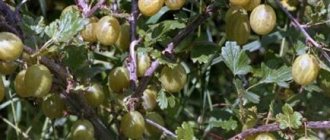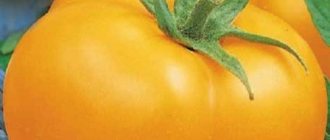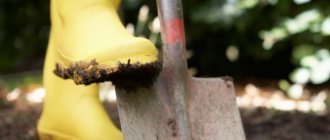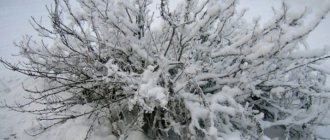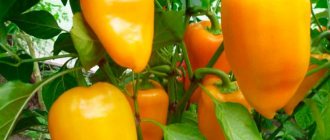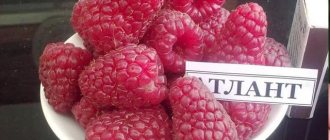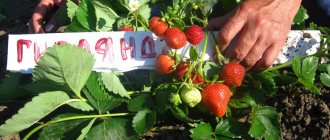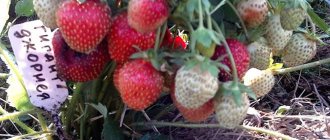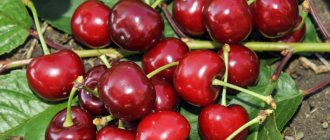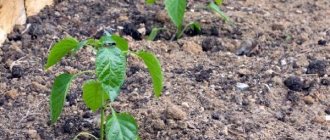| № | Name | Rating | Nomination |
| 1 | Loch Tay | 4.80 | The earliest. Better yield |
| 2 | Black Satin | 4.75 | The most popular variety |
| 3 | Black Butte | 4.70 | Berries up to 6 cm long and weighing up to 20 g |
| 4 | Natchez | 4.65 | Best keeping quality of berries |
| 5 | Gloria | 4.60 | The sweetest berries |
| 6 | Guy | 4.55 | Blackberry with mulberry flavor |
| 7 | Thornfree | 4.50 | Unpretentious variety |
| 8 | Agawam | 4.45 | Better frost resistance |
| 9 | Karaka Black | 4.40 | Attractive looking berries |
| 10 | Polar Berry | 4.35 | White blackberry |
In the climate of the Moscow region, most varieties of blackberries presented in nurseries can be successfully grown. The best of them are characterized by sufficient frost resistance, although they still require shelter for the winter, are immune to disease, and produce an excellent harvest. Particularly popular are thornless blackberries, which will not injure the skin during berry picking and care. To obtain a full harvest in the Moscow region, it is recommended to choose predominantly early-ripening varieties.
Blackberries are incredibly healthy and have many healing properties. They help strengthen the heart and blood vessels, improve immunity, improve metabolism and activate brain activity. The size of the berries ranges from relatively small to very large, reaching a weight of 20-25 grams. They usually ripen not at the same time, but over the course of several weeks.
Top 10. Polar Berry
Rating (2021): 4.35
White blackberry Polar Berry is a blackberry with white berries, which are valued primarily for their unusualness and originality.
- Characteristics
Berry weight: 5-11 g
- Ripening date: 1st decade of August
- Average yield: 5-6 kg
Polar Berry is a self-fertile and disease-resistant variety of blackberry that tolerates winter cold well, but still overwinters better under cover. It is valued for the unusual white color of its berries, which look incredibly decorative. The bush is compact; shoots rarely reach 2.5 meters in length, but most often do not grow more than 1.2-1.5 meters. Spikes are present, but there are relatively few of them. The berries are medium in size, the yield per bush is about 5 kg. Due to their white color, the berries lack anthocyanins, which some say reduces their health benefits. But Polar Berry is valued more for its unusualness, so it is worth planting it on your plot for those who already have experience growing blackberries and want something new.
Advantages and disadvantages
- White color of berries
- Relatively short shoot length
- Self-fertility
- Immunity to disease
- Average yield
- Requires shelter for the winter
The best varieties of blackberries
Blackberries vary by variety. Each has its own characteristics: the size and taste of the berries, the type and shape of the bush, winter hardiness and others. Let's look at the best varieties of blackberries for summer cottages.
IMPORTANT! Only 3 varieties of blackberries are included in the State Variety Register of the Russian Federation: Agavam, Agatovaya, Thornfree.
Let's start with the varieties zoned and recommended for planting in Russia.
Blackberry Agawam
Agavam blackberries were included in the State Register of the Russian Federation in 2006. This is a dessert variety, early ripening, the berries are suitable for freezing and processing.
The bush is medium-sized and powerful. The shoots of this variety are thick, pentagonal with arched drooping tops. Shoot-forming ability is average.
Biennial shoots are brown, straight, annual shoots are brown. The spines are brown, medium-sized, hard, curved, tip down, with a base. Lateral fruiting branches with a weak waxy coating, medium pubescent.
Agave berries are medium in size, weighing 4.5-5.0 g, oval in shape, black in color, sweet and sour, delicate with aroma.
Tasting assessment of fresh berries is 3.5 points, processed berry products - 4.0 points.
The average yield is 99.8 c/ha. Tolerates short-term frosts down to -25-30° without shelter. Heat resistance is weak, drought resistance is average.
It can be damaged by weevils, under certain cultivation conditions it is affected by didimella, berries - by gray rot.
Video: Agawam blackberry yield
Advantages and disadvantages of Agave
Advantages:
- stable fruiting,
- in the central region does not require shelter for the winter,
- drought-resistant and shade-tolerant.
Flaws:
- prickly tall shoots,
- shoots can grow 3 m from the mother bush.
It is recommended to plant Agave blackberries in sunny areas for better ripening of the berries.
The distance between bushes must be maintained at least 1 meter, between rows 1.8-2 meters. Experienced gardeners recommend tying the shoots to a trellis.
Blackberry Agate
The blackberry variety Agatovaya was included in the State Register of the Russian Federation in 2016.
Medium ripening, non-repairable, universal purpose.
The bush is semi-vertical, powerful. Escape performance is average. Biennial stems are purple-brown and straight. Annual shoots are purple, without a waxy coating, slightly pubescent, without thorns.
The lateral fruiting branches are slightly pubescent, with a slight waxy coating.
The berries are quite large, with an average weight of 4.8 g, maximum weight up to 6.3 g, conical in shape, black. They contain: sugar - 8.1%, acid - 1.8%, vitamin C - 8.8 mg%.
The pulp is tender, sweet and sour, without aroma. The tasting rating of fresh berries is 4.8 points.
Advantages and disadvantages of Agate
Advantages:
- drought resistance and heat tolerance.
Flaws:
- froze up to 1.5 points, at a temperature of -24°C.
- was affected by diseases and pests to a moderate degree.
Planting is the same as the previous variety. Bushes need shelter for the winter in the Moscow region.
Blackberry Thornfree
The thornfree variety was included in the State Register of the Russian Federation in 2006.
This is a dessert variety, late ripening, the berries are suitable for freezing.
The bush is low-growing, powerful, semi-creeping. The shoots are raised, become creeping as they lengthen, thornless, thick, round-faceted, almost round.
The shoot-forming ability is weak, biennial shoots are brown, annual shoots are purple, the pubescence is medium and simple.
Thornfree berries are large, shiny, weighing 4.5-5.0 g, oval in shape, black in color, sweet, tender with a faint aroma.
Tasting assessment of fresh berries - 4 points, processed products - 3 points.
Advantages and disadvantages of Thornfree blackberries
Advantages:
- Heat and drought resistant.
Flaws:
- The variety freezes slightly every year, but bears fruit annually on lateral shoots formed on the lower nodes of a two-year-old shoot.
- Can be damaged by mice and weevils.
- The berries are affected by gray rot.
Top 9. Karaka Black
Rating (2021): 4.40
The attractive appearance of Karaka Black berries is not fully suitable for growing in the Moscow region, but it tempts gardeners with its beautiful elongated berries.
- Characteristics
Berry weight: 10-15 g
- Ripening date: 1st decade of August
- Average yield: 15 kg
Karaka Black is a relatively new variety of New Zealand selection that has already become popular. It attracts with the expressive shape of the berries, elongated to 5 cm, the weight of which reaches 15 grams at the beginning of fruiting. Unlike many others, this variety produces fairly transportable fruits that can remain marketable for 5 days. This variety can only be called conditionally suitable for growing in the Moscow region, since its frost resistance is low. But you can find many reviews from gardeners who cover the shoots for the winter, providing them with optimal conditions for wintering. The shrub forms quite powerful shoots up to 5-6 meters long. A large number of thorns makes care somewhat difficult.
Advantages and disadvantages
- Weight and decorative appearance of berries
- Excellent yield
- Good growth
- Low frost resistance
- Prickliness
Jumbo
Jumbo is a hybrid of French selection. Its main advantage, which distinguishes Jumbo from other varieties and hybrids of blackberries, is the fruits’ enormous size (by blackberry standards): the berry grows up to 30 g. The total yield per bush can reach 25-30 kg. Active fruiting begins the next year after planting.
Jumbo fruits are not only large, but also tasty. Sweet, with only a slight sourness, dense, but juicy berries are well stored and are suitable for transportation over long distances. After harvesting, they can remain in the refrigerator for a week without losing their shape or taste.
Another advantage of Jumbo blackberries is their resistance to high temperatures. The berries do not bake in the heat, and the plant’s productivity does not decrease. The composition of the soil and slight shading also do not affect the amount of harvest.
But negative temperatures have a negative effect on the plant. The frost resistance of Jumbo blackberries is low, so the bushes in the middle zone definitely require shelter. This is perhaps the only drawback of this hybrid.
Otherwise, Jumbo evokes only positive reviews from gardeners, who note its unpretentiousness, resistance to diseases and pests, as well as the absence of thorns on the shoots, which is important when caring for blackberries.
Top 8. Agawam
Rating (2021): 4.45
Best frost resistance Agave is one of the few varieties that can winter in the climate of the Moscow region without additional shelter for the shoots.
- Characteristics
Berry weight: 4-5 g
- Ripening date: 1st decade of August
- Average yield: up to 10 kg
Agave is one of the oldest varieties of blackberries, which has been known for more than a hundred years. He has both fans and opponents. The first are attracted by the unpretentiousness and rapid reproduction of this blackberry variety, its frost resistance (a number of sources indicate up to -39, somewhere up to -30). The latter criticizes the size and taste of the berries, their lack of keeping quality, sharp thorns and the rapid growth of the bush. The fruits are really small, similar to forest fruits. If you pick them unripe, the taste is unlikely to impress, but if you wait until they are fully ripe, it should not disappoint. But it will not be possible to store completely ripe berries; they must be processed immediately. In general, Agave can be included among the best varieties, if only because its shoots do not need to be covered during the winter, even when grown in the Moscow region.
Advantages and disadvantages
- An old and well known variety
- Winter-hardy, does not require shelter
- Reproduces quickly
- The berries are small, not everyone likes their taste
- The shoots sometimes behave quite aggressively
Winter-hardy
These varieties are suitable for cultivation in Siberia and the northern regions of the Russian Federation. Although they tolerate frost well, most gardeners still advise covering them with straw or non-woven material for the winter.
Agawam
An old variety of blackberry, included in the state varietal register, suitable for cultivation in Russia. It bears fruit for 15 years. The shoots grow straight, powerful, prickly, reaching a height of 3 m. It survives drought and frosts down to -40 degrees well, and does not require shelter.
Related article:
How to properly form blackberries. Six tips
In the southern regions, the plant is planted both in the shade and in the sun. For northern regions, sunny areas are recommended, since the berries do not have time to ripen. When planting, a distance of up to 1 m is maintained between seedlings, and up to 2 m between rows. Long shoots are placed on trellises.
The berries are sweet, weighing up to 5 g. On average, up to 6 kg are collected from one bush. Despite many advantages, Agavam also has a disadvantage - it has thorns and numerous shoots, which cause a lot of trouble.
Arapaho
A winter-hardy variety that can withstand short-term frosts of -24 degrees. The bushes are upright, without thorns, up to 2.5 m in height. The peculiarity of the crop is that the side branches bear fruit.
The berries are black, conical in shape, with a pleasant taste and small seeds that are almost unnoticeable. The weight of each reaches 8 g. The yield is influenced by the region in which the crop grows. Transportability of the crop dried for 2 days.
Gazda
Polish variety, which is a spreading powerful bush, reaching a height of 2 m. The branches are long, elastic, almost without thorns. The culture survives frosts well down to -30 degrees. The plant is not afraid of disease and drought.
The berries are round, large, up to 7 g. When ripe, they have a rich black tint and a glossy surface, with a sweet and sour taste. Harvest in late summer or early autumn.
Polar
Large-fruited blackberry, bred by Polish breeders. The variety survives frosts down to -30 degrees, and shelter is not necessary. But experienced gardeners say: if the plant is covered, the yield increases significantly.
Related article:
The best blackberries for the Moscow region
The stems grow straight, reaching a height of 2.5 m. If you bend them towards the ground, they break. To prevent this from happening, the shoots are bent down while they are still young, before they become lignified.
The berries are large, weighing up to 12 g. In the south they ripen as early as July. They are sweet, withstand transportation well, and are rarely affected by pests and diseases. Feedback from gardeners when describing this blackberry variety is mostly positive. The variety of the crop is unpretentious, but prefers loamy soils and sunny areas.
Good to know! What berry bushes to plant on the plot
Flint
An upright variety that can withstand frosts down to -40 degrees. A lush bush is formed from branched shoots, reaching 1.5 m in height in the first year of life. In subsequent years it doubles. The spines are sparse and pointed.
The fruits are round in shape, aromatic, weighing up to 7 g, and are easily transported. They stick well to the branches, so you have to put in some effort when harvesting. It bears fruit the following year after seedlings are planted. If the plant receives little moisture, the berries begin to taste bitter. From 1 bush they harvest up to 10 kg per season.
Top 7. Thornfree
Rating (2021): 4.50
the unpretentious variety Thornfree one of the most unpretentious varieties of blackberries, caring for which will not be difficult.
- Characteristics
Berry weight: 7-10 g
- Ripening date: 1st decade of August
- Average yield: 10-12 kg
The thornless Thornfree blackberry was bred in the USA for industrial cultivation, and therefore is distinguished by its unpretentious care, high yield and the possibility of long-term storage of the harvested crop. The berries are of average size 7-10 grams, but there are up to 20 of them on one inflorescence, which, with shoots up to 5 meters long, allows you to get up to 10-12 kg, and with proper care even more. Thornfree has average frost resistance; when grown in the Moscow region, it is recommended to cover it. Judging by the reviews, in snowy winters the shoots do not freeze out even without additional shelter, but it is better not to take the risk. The variety has an average ripening period; in cool summer and autumn in the Moscow region, not the entire crop may ripen, but only part of it.
Advantages and disadvantages
- Thornless
- Industrial unpretentious variety
- Transportability of berries
- In cool summers, not all berries ripen
- Needs to be covered for winter
Is it profitable to grow blackberries?
What profit will blackberry growing as a business bring? According to experienced entrepreneurs, from one hectare you can collect from 7 to 20 tons of berries. If we take the average value of 16 t/ha, then the total yield from the site will be 32 tons. The farmer will sell some of these fruits wholesale, and some at retail:
Revenue from growing blackberries
| Income item | Quantity, kg | price, rub. | Amount, rub. |
| Selling blackberries wholesale | 24000 | 80 | 1920000 |
| Retail sale of blackberries | 8000 | 180 | 1440000 |
| Total: | 32000 | – | 3360000 |
Considering the amount of overhead costs, it can be assumed that the economic efficiency of growing blackberries will exceed the profitability of growing raspberries as a business. However, in the first year the entrepreneur will not yet receive a harvest, and therefore the initial investment will pay off only in the third summer:
Profitability of growing blackberries
| Index | 1–2 year | 3 year |
| Revenue for the period, rub. | 3360000 | 3360000 |
| Expenses for the period, rub. | 1045848 | 546174 |
| Profit, rub. | 2314152 | 2813826 |
| Unified agricultural tax 6%, rub. | 138852 | 168826 |
| Net profit for the period, rub. | 2175300 | 2645000 |
| Profitability, % | 207,9 | 484,2 |
| Capital investments, rub. | 4267750 | |
| Payback period, years | 3 | |
Top 6. Guy
Rating (2021): 4.55
Blackberries with mulberry flavor Many people compare the berries of the Gai variety in taste to mulberries, talking about their pleasant aroma and characteristic notes.
- Characteristics
Berry weight: 8-16 g
- Ripening date: 3rd decade of July
- Average yield: up to 17 kg
The blackberry variety Gai was developed in Poland relatively recently, namely in 2006. It is thornless, winters without shelter in its homeland and theoretically tolerates frosts down to -30, but in the conditions of the Moscow region, gardeners try to provide it with additional protection from winter cold. The berries begin to ripen in the second half of July, delighting with a pleasant taste and characteristic aroma. Some reviews say that Gai is somewhat reminiscent of mulberry in taste. The first berries are quite large, reaching 15-16 grams, the subsequent ones are somewhat smaller, the yield is excellent. The fruits are quite elastic, so many people plant this variety to sell berries.
Advantages and disadvantages
- Thornless
- Large and tasty berries
- High yield
- It is better to cover for the winter
Top 5. Gloria
Rating (2021): 4.60
The sweetest berries Blackberries of the Gloria variety contain up to 12% sugars, which makes them one of the sweetest.
- Characteristics
Berry weight: 8-10 g
- Ripening period: 2nd decade of July
- Average yield: up to 20 kg
Gloria is a new thornless blackberry variety of Polish selection. Nurseries began offering it to gardeners relatively recently, so there are no real reviews yet, but the characteristics given by sellers are impressive. So, this is an early variety; the berries begin to ripen in mid-July. The weight of the fruit is average, approximately 8-10 grams, the color is rich with a glossy sheen. The sugar content in the berries is high and reaches 12%; they are called one of the sweetest. Even with incomplete ripening, they do not feel acidic or astringent. After harvesting, the harvest lasts up to 7-10 days. Sellers call Gloria's winter hardiness high, but do not give exact figures, so covering the shoots will not be superfluous.
Advantages and disadvantages
- Sweet berries
- Thornless
- High yield
- Transportability and keeping quality
- New variety, no real reviews
Top 4. Natchez
Rating (2021): 4.65
Best keeping quality of berries Berries are distinguished by incredible keeping quality and transportability, being preserved for up to 15 days.
- Characteristics
Berry weight: 14-22 g
- Ripening date: 3rd decade of July
- Average yield: 13-15 kg
Natchez is a thornless variety of blackberry, bred in the USA and widely spread in Russia. Its powerful shoots reach a height of 5 meters, require obligatory gartering to a support in the form of a trellis, and can sometimes break from the weight of the fruit. The variety does not tolerate severe cold well, so it is covered for better preservation in the winter. Natchez berries are very large, individual weights can exceed 20 grams. They are collected in clusters of 13-15 pieces, which guarantees high yields of up to 15 kg per bush. Another advantage is their incredible shelf life and the ability to maintain their presentation for up to half a month. The taste of the berries is excellent; many note cherry notes in it. The variety is quite drought-resistant, but during the ripening period the berries require regular watering.
Advantages and disadvantages
- Thornless
- High yield
- Large and tasty berries
- Keeping quality of fruits
- Shelter required for winter
- Brittle shoots
See also:
- 10 best blueberry varieties for the middle zone
Foreign best varieties of blackberries
Currently, seedlings of new blackberry varieties have appeared on the market. From one bush, as manufacturers claim, you can collect up to 2 buckets of berries. These are American and Polish brambles and dewberries.
Blackberry Natchez
Natchez blackberries are a variety of American selection, medium-early ripening, thornless, high-yielding. The berry is sweet and large (up to 12 grams), elongated, glossy black. The high sugar content (9.5%) makes it an ideal dessert berry. The bush is vigorous, semi-erect with long shoots. It is recommended to tie the shoots to a trellis. The productivity of the variety is high. It is of great interest for growing on farms and in the countryside, thanks to its large berries and high taste.
Blackberry Triple Crown
The variety is semi-creeping, thornless, high-yielding. The bush produces almost no root shoots.
Belongs to sundews, the shoots are vigorous, up to 3-4 m. Requires garter on a trellis. Suitable for both industrial and amateur gardening.
The berries are dark, glossy, round, transportable, average weight 8-9 grams, excellent taste, suitable for fresh consumption and all types of processing.
The variety does not overwinter well without shelter.
Blackberry Orcan
Variety of Polish selection. Very early ripening.
The berries are collected in large multi-berry clusters. The berry is large, oblong in shape, with a sweet and sour pleasant taste. The color of the berry is black with a glossy sheen.
Stems are erect, thornless, shoots up to 3 m long.
Winter hardiness - up to -25 degrees. Requires shelter in the middle zone.
The variety is productive, resistant to pests and diseases.
Blackberry Polar
Blackberry variety Polar of Polish selection. The bushes are erect up to 2.5 m, frost-resistant, thornless.
Ripening period is early.
The berry is large - up to 10 grams, sweet. Productivity is average.
Advantages:
- early maturation,
- frost resistance - up to -30 degrees;
- large and tasty berries;
- shoots without thorns;
- resistant to diseases;
- good transportability.
Flaws:
- brittle shoots - difficult to cover for the winter,
- does not like damp, waterlogged places.
Blackberry variety Waldo
Waldo is an old and proven, thornless, creeping blackberry variety with a mid-early ripening period (July).
Berries weighing 6-7 grams. pleasant taste and aroma, they begin to ripen in the first ten days of July.
Bushes creeping, compact. The length of the shoots does not exceed 2 meters and require support.
Winter hardiness is average; winter shelter is required for this bush. Advantages:
- absence of thorns,
- ideal for small areas.
Flaws:
- in hot weather the berries are baked.
Blackberry variety Oauchito
Oauchita is a vigorous, thornless, large-fruited blackberry of medium ripening
Video variety Oauchita:
The berries are large - on average 6-7 g and with a very original sweet, slightly acidic taste; they begin to ripen in June. Fruiting is extended and lasts almost two months.
The bushes are powerful, erect, shoots grow up to 2-3 meters. Prefers sunny places and well-drained soils. The distance between seedlings for this blackberry variety is 1.5-2 meters.
The plant must be covered for the winter.
Advantages:
- extended ripening period,
- amazing yield
- disease resistance,
- berries with an original taste do not lose their commercial qualities for a long time.
Flaws:
- low frost resistance -17º, need to bend down for the winter.
Blackberry variety Black Magic (Black magic)
Black Magic is a remontant blackberry variety. The plants are powerful, prickly, the height of the shoots is 1.5-2 m. Excellent productivity and good taste of the fruits make it very attractive to gardeners.
The distance between bushes is at least 1-1.5 meters.
When covered for the winter, the yield increases.
Video on the Black Magic blackberry variety:
Blackberry Loh Tay
Loch Tay is a large-fruited, thornless, medium-ripening blackberry bred in Scotland.
The declared yield is 10-12 kg. from every bush. The berries are large, weighing about 5 grams. The taste is sweet and sour; they ripen in mid-July.
Loch Tay has a semi-creeping bush form. The shoots are vigorous, elastic, up to 5 meters long, and require gartering on trellises. The frost resistance of the bushes is average; they require shelter for the winter.
When planting, maintain a distance of at least 2 m between bushes.
Propagated by digging in the tops of replacement shoots. The transportability of the berries is excellent.
Advantages and disadvantages of the Loch Tay variety
Advantages:
- good yield
- absence of prickly thorns,
- great berry taste
- good transportability.
Flaws:
- it is necessary to cover the bushes for the winter
Blackberry Reuben
Ruben is a remontant variety, large-fruited, thorny blackberry. Productivity up to 3.5 kg per bush. The berries are sweet, large, average weight about 10 g. They ripen in late June and late August. The shoots are erect, vigorous, with thorns.
Blackberries can withstand temperatures as low as -16º; shelter for the winter is required.
Advantages and disadvantages of blackberry Reuben
Advantages:
- tolerates shade well
- excellent transportability of berries.
Flaws:
- low frost resistance,
- To obtain a harvest on annual shoots, it requires greenhouse conditions,
- problems with pollination.
Blackberry Prime Arc Freedom (Premier Arc Freedom)
A remontant variety of blackberry without thorns. An erect bush, shoot height up to 2 m. Average berry size 9 g. Sweet taste.
Ripening - first fruiting is early on shoots 2 years old, 9-11 days earlier than Natchez and 16-18 days earlier than Ouachita.
Advantages and disadvantages of Prime Arc Freedom
Advantages:
- sweet taste and large size of berries,
- repairability,
- good transportability.
Flaws
- the opportunity to get 2 harvests only in the southern regions,
- low frost resistance.
Blackberry Karaka Black
An Arkansas blackberry produced by crossing Darrow x Brazos.
The berries are small, elongated, black and very shiny, easy to pick. Average weight 10-11g, more than Kotata and Waldo.
The shelf life of the berries is outstanding. The yield is high, approximately 15 t/ha, compared to the varieties Silvan 13 t/ha and Waldo 10 t/ha.
Karaka Black has a very long fruiting season and produces high quality fruit within six to eight weeks.
The moderate vigor of the shoots makes it advisable to plant this variety at a distance of 1 m to ensure high yield. In cool climates, these bushes will be good for growing in greenhouses.
Advantages and disadvantages of Karaka Black
Advantages:
- beautiful, large berry,
- transportable,
- keeps well, does not wrinkle.
Flaws:
- low frost resistance - winter shelter is required,
- a garter on the trellis is required,
- overripe berries fall off.
Blackberry Columbia Star
New thornless variety of blackberry (dewberry) from Oregon. High-yielding bushes with berries of the same size 10-15 g, conical in shape. The taste is sweet with sourness and aromatic notes of raspberry.
Creeping bushes, shoots 4-5 meters long, without thorns. Winter hardiness of Columbia Star is low -12 degrees; winter shelter for bushes is required.
Advantages and disadvantages of Columbia Star blackberries
Advantages:
- tasty, large berries with a cherry flavor,
- retain their presentation for a long time,
- high productivity,
- The shoots are quite soft and without thorns and can be easily pressed to the ground for winter shelter.
- easily tolerates heat and drought.
Flaws:
- low frost resistance - shelter is required,
- long shoots with many lateral shoots can be difficult to untangle when removed from the support.
Top 3. Black Butte
Rating (2021): 4.70
Berries up to 6 cm long and weighing up to 20 g Black Butte is an early variety with elongated berries reaching 6 cm and weighing 20 grams.
- Characteristics
Berry weight: 12-20 g
- Ripening period: 1st decade of July
- Average yield: up to 6 kg
Black Butte or Black Butter is another early variety of blackberry, which, provided it is covered for the winter, grows well and bears fruit in gardens near Moscow. The frost resistance of the plant is down to -29 degrees, but without exception, everyone who grows it on their plots practices additional protection from the cold. The main feature of Black Butte is its berries up to 6 cm long and weighing up to 20 grams. They ripen within several weeks and can be stored in the refrigerator for up to 7-10 days. Black Butte grows quite quickly, but in general it is compact, since the shoots rarely exceed 3 meters. Hence the declared yield is not as high as that of many other varieties.
Advantages and disadvantages
- Large, attractively shaped berries
- Keeping quality of fruits
- Frost resistance
- Average yield
See also:
- 10 best blueberry varieties for the Moscow region
Top 2. Black Satin
Rating (2021): 4.75
The most popular variety Judging by the number of reviews, discussions on forums and the number of requests in search networks, Black Satin is one of the most popular blackberry varieties for the Moscow region.
- Characteristics
Berry weight: 6-8 g
- Ripening date: 3rd decade of July
- Average yield: 12-14 kg
Black Satin is one of the most popular varieties of thornless blackberries for the Moscow region. It is quite frost-resistant, and even if the shoots freeze, it quickly recovers. Experienced gardeners in their reviews still recommend making at least minor shelter for the bushes. The berries of this variety are medium in size. When fully ripe, they are very sweet, in the semi-ripe stage with slight sourness. Their shelf life is minimal, so it is recommended to immediately eat the crop or use it for processing. Productivity depends on the age of the bush and proper care. Black Satin seedlings grow quickly. The first 1.5 m of height have a vertical direction, then the shoots begin to creep.
Advantages and disadvantages
- High yield
- Pleasant taste
- Berries do not fall off when ripe
- Good immunity
- It is recommended to cover for the winter
- Berries need to be processed immediately
See also:
- 10 best blackcurrant varieties for the Moscow region
Useful tips
Blackberries are not a very capricious berry, but they still require careful care. To optimize this process, you need to use the recommendations of experienced summer residents:
- When purchasing seedlings, you should pay attention to the roots. They must be strong and well developed. Otherwise, it will not be possible to grow a large bush.
- The plant loves sunlight. Because of this feature, it needs to be planted in open areas.
- Bushes die quickly if the soil is over-moistened. The plant needs to be watered only during drought and high air temperatures.
- You can feed the plant with nitrogen, potassium and phosphorus fertilizers.
Blackberries are considered one of the most delicious and healthy berries. If you follow all the rules for planting and caring for it, you can grow sweet, aromatic berries.
